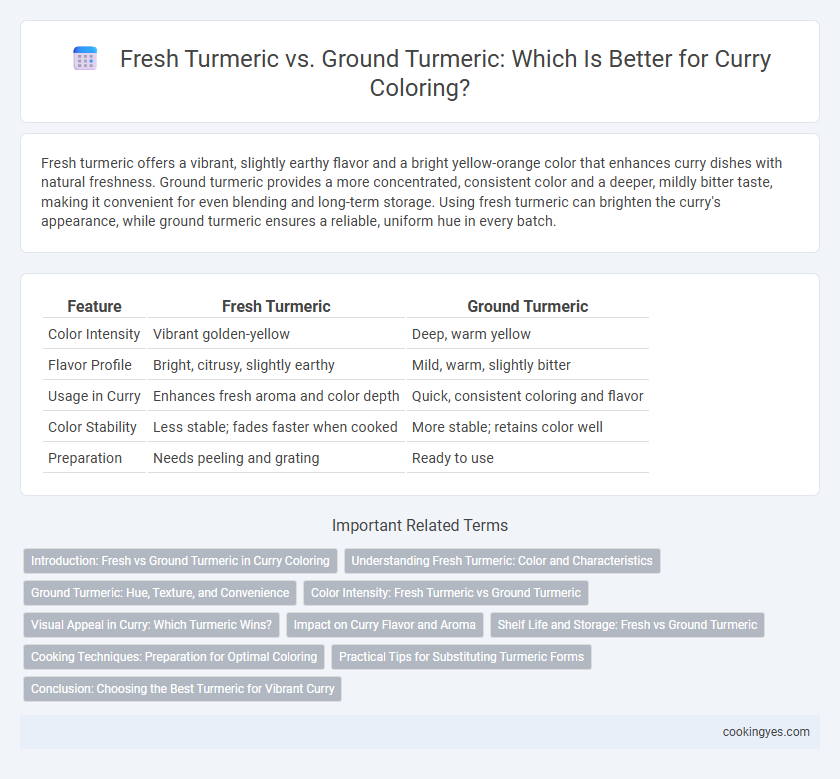Fresh turmeric offers a vibrant, slightly earthy flavor and a bright yellow-orange color that enhances curry dishes with natural freshness. Ground turmeric provides a more concentrated, consistent color and a deeper, mildly bitter taste, making it convenient for even blending and long-term storage. Using fresh turmeric can brighten the curry's appearance, while ground turmeric ensures a reliable, uniform hue in every batch.
Table of Comparison
| Feature | Fresh Turmeric | Ground Turmeric |
|---|---|---|
| Color Intensity | Vibrant golden-yellow | Deep, warm yellow |
| Flavor Profile | Bright, citrusy, slightly earthy | Mild, warm, slightly bitter |
| Usage in Curry | Enhances fresh aroma and color depth | Quick, consistent coloring and flavor |
| Color Stability | Less stable; fades faster when cooked | More stable; retains color well |
| Preparation | Needs peeling and grating | Ready to use |
Introduction: Fresh vs Ground Turmeric in Curry Coloring
Fresh turmeric offers a vibrant, earthy flavor and a bright yellow-orange color that enhances curry dishes naturally. Ground turmeric, while convenient, provides a more concentrated, slightly bitter taste and a deeper, uniform golden hue. The choice between fresh and ground turmeric significantly impacts the aroma, color intensity, and overall sensory experience of curry.
Understanding Fresh Turmeric: Color and Characteristics
Fresh turmeric delivers a vibrant orange-yellow hue and a more intense, earthy aroma compared to ground turmeric, enhancing curry's visual appeal and flavor complexity. Its high moisture content and essential oils contribute to a brighter color and fresher taste, which tend to diminish during the drying and grinding process. Using fresh turmeric in curry ensures a richer color and more robust antioxidant properties, making it a preferred choice for authentic and health-conscious recipes.
Ground Turmeric: Hue, Texture, and Convenience
Ground turmeric offers a vibrant golden hue essential for authentic curry coloring, enhancing both visual appeal and flavor depth. Its fine texture ensures even blending without clumps, providing a smooth consistency in sauces and gravies. Convenient and shelf-stable, ground turmeric delivers reliable potency and ease of use compared to fresh turmeric's variable intensity and preparation time.
Color Intensity: Fresh Turmeric vs Ground Turmeric
Fresh turmeric delivers a more vibrant and intense yellow-orange hue in curry compared to ground turmeric, due to its higher concentration of curcumin pigments. Ground turmeric, while convenient, often displays a slightly duller color as drying and processing can degrade some of its natural pigments. Using fresh turmeric enhances the visual appeal of curry with richer color intensity, making it preferable for dishes where bright, bold coloring is desired.
Visual Appeal in Curry: Which Turmeric Wins?
Fresh turmeric delivers a vibrant, bright orange-yellow hue that enhances the visual appeal of curry with a natural, rich color intensity. Ground turmeric offers convenience and a consistent, warm yellow tone but may lack the depth and brightness seen with fresh turmeric. For dishes emphasizing eye-catching presentation, fresh turmeric's vivid pigmentation often wins over the muted shade provided by ground turmeric.
Impact on Curry Flavor and Aroma
Fresh turmeric imparts a vibrant, earthy flavor and a subtle citrus aroma to curry, enhancing its overall freshness and complexity. Ground turmeric, while convenient, has a more concentrated, slightly bitter taste and a muted aroma due to drying and processing. Using fresh turmeric can intensify the curry's fragrance and flavor depth, whereas ground turmeric provides consistent color but a less dynamic aromatic profile.
Shelf Life and Storage: Fresh vs Ground Turmeric
Fresh turmeric offers vibrant color and a more potent aroma but has a shorter shelf life, typically lasting about two to three weeks when stored in the refrigerator. Ground turmeric, while less intense in flavor, provides consistent coloring and retains its quality for up to three years when stored in a cool, dark, and dry environment. Proper storage of ground turmeric helps preserve its curcumin content, which is crucial for maintaining the bright yellow hue in curry dishes.
Cooking Techniques: Preparation for Optimal Coloring
Fresh turmeric offers a vibrant orange hue and a more intense flavor when grated or finely chopped directly into curry, releasing essential oils that enhance color vibrancy. Ground turmeric powder provides consistent coloring and ease of use but may lose some potency and brightness compared to fresh turmeric, especially if old or improperly stored. To optimize curry coloring, lightly frying turmeric in oil at the beginning of cooking helps activate curcumin pigments, intensifying both color and aroma regardless of the form used.
Practical Tips for Substituting Turmeric Forms
Fresh turmeric offers a vibrant, earthy flavor and bright yellow-orange color that enhances curry's visual appeal, while ground turmeric provides concentrated color and convenient shelf life. When substituting, use one tablespoon of freshly grated turmeric to replace one teaspoon of ground turmeric, adjusting based on desired intensity and texture. To preserve color vibrancy, add fresh turmeric early in cooking, whereas ground turmeric can be stirred in at any stage without compromising the curry's rich golden hue.
Conclusion: Choosing the Best Turmeric for Vibrant Curry
Fresh turmeric delivers a more intense and vibrant yellow-orange hue to curry compared to ground turmeric, which tends to have a milder color due to processing. While ground turmeric offers convenience and longer shelf life, using fresh turmeric root enhances the visual appeal and imparts a richer flavor profile. For the most vibrant curry coloring, selecting fresh turmeric is the optimal choice.
Fresh turmeric vs ground turmeric for curry coloring Infographic

 cookingyes.com
cookingyes.com